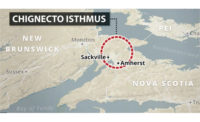Facing Flood Cost Fallout, Canada Explores Insurance Changes

Road washout from mid-November rain deluge in British Columbia leaves rail line barely supported.
PHOTO: B.C. Dept. of Transportation and Infrastucture
Massive flooding that paralyzed British Columbia in November caught the province unprepared in more ways than one, with underinsurance emerging as a major issue.
While insurers have agreed to cover roughly $450 million in damages caused by heavy rains, the total recovery costs are likely to climb into the billions.
Even with an initial $5 billion in promised federal government flood disaster relief, 2021 will be “the costliest insured event in the province’s history,” said Rob de Pruis, director of consumer and industry relations at Insurance Bureau of Canada. Ken Peacock, chief economist at the Business Council of British Columbia, said flooding is set to cause lost economic output ranging from $250 million to $400 million, not including repair and rebuilding costs.
Overland flood insurance, as opposed to coverage for homes and businesses near rivers or the coast, has only been offered in Canada for a few years, says de Pruis. The coverage developed after devastating floods in Calgary in 2013 caused an estimated $5 billion in damage, of which insurers covered only $1.8 billion.
“Flood insurance is fairly new to the market and can have limited availability in high-risk areas,” says Aaron Sutherland, a B.C.-based bureau vice president. The bureau says up to 10% of British Columbians cannot buy any flood insurance because they live in areas that are too high-risk.
Canadian experts also issued recommendations to prepare the country to cope with the impact of more extreme weather. Canada now faces 100 weather disasters each decade, defined as those with 10 or more people killed or 16 or more injured or left homeless, up from 30 such events in the 1960s, says a new report by a Council of Canadian Academies panel.
In the past decade, the federal disaster financial assistance program has provided $330 million per year on average, or triple its appropriation, says the report, “Building a Resilient Canada.”
Private insurance coverage across Canada for the past few years after various natural disasters has consistently topped $2 billion annually, a four-to-fivefold hike from two decades ago. The report cites the need for more incentives to discourage rebuilding in high-risk areas. The insurance bureau and federal government will issue a joint report in the spring on low-cost insurance coverage options for high-risk residential areas, including the potential of managed relocations.



